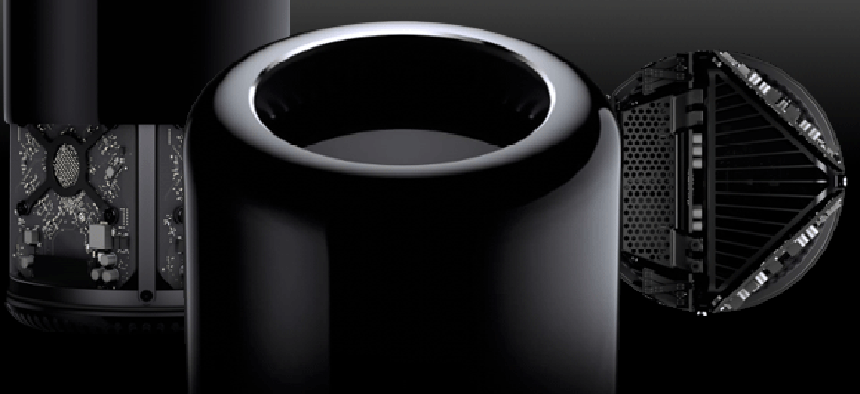Apple's new Mac Pro a move toward serious desktop computing

Inside its cylindrical design are the makings of a powerhouse workstation that could make some agencies take a second look.
While Apple has been able to push into government for the mobile space, even into the most conservative agencies like those in the Defense Department, it has struggled to even dent the near monopoly Microsoft Windows-based PCs have on desktops. Apple moved a little bit closer to success with OS X Mountain Lion, which we found to be a robust OS with many good security features.
But there is still the issue of hardware performance. It's not all that difficult for a PC-based company to build out a powerful system, as we have seen with many workstations coming through for review lately. But Apple never seemed to have the desire or the will to create a desktop supercomputer for its platform.
That all might change with the introduction of the new Apple Mac Pro. The sleek black cylinder introduced by Apple is actually a powerful workstation-class system. It can have up to 12 cores of processing power, up to 40 gigabits/sec of PCI Express bandwidth, and it can handle 256-bit-wide floating-point instructions. The memory is even more impressive, with speeds up to 60 gigabits/sec.
Each Mac Pro will feature two AMD FirePro workstation-class GPUs and fast flash hard drives.
But the true engineering marvel is really the way the little cylinder is able to keep cool. The entire system is built around a unified aluminum thermal core. Because it's one piece, if one of the processors is running hard and the other isn't, the heat from the hot part of the cylinder is diffused around to the cooler side. Then there is a single fan that pulls air in from the bottom of the unit, drags it along the core and vents heat out the top. Even the fan was carefully designed to be as efficient as possible. For air-flow nerds, it has backward-curved impeller blades that run at fewer revolutions per minute and are very quiet.
In terms of ports, the Mac Pro uses Thunderbolt 2 technology, which is among the fastest out there right now, about 25 times faster than a FireWire 800 port. There are also USB 3 ports, Gigabit Ethernet and four HDMI 1.4 ports, each one capable of driving a different display. It's also fairly small, at only 9.9 inches tall and 6.6 inches wide.
One thing that Apple didn't mention at the unveiling this week was the price, though it’s a safe bet that it's probably going to be expensive. A current generation Mac Pro configured like a standard box starts at about $2,500, but custom extras can push that as high as $12,000 or more. It's hard to imagine that this new machine won't be more expensive.
There is also the question of expandability. While there are plenty of ports for external components, what's inside the cylinder can't be easily changed. There are no standard video cards or PCI cards that would fit it, which may be a hard fact for desktop users to face. Then again, with one of the fastest systems on the market, there may be no need to expand.
In any case, the Mac Pro should make agencies that need high-powered desktops give Apple a second look. It may not be the perfect cylindrical peg for government's square hole, but it may fit nonetheless.





